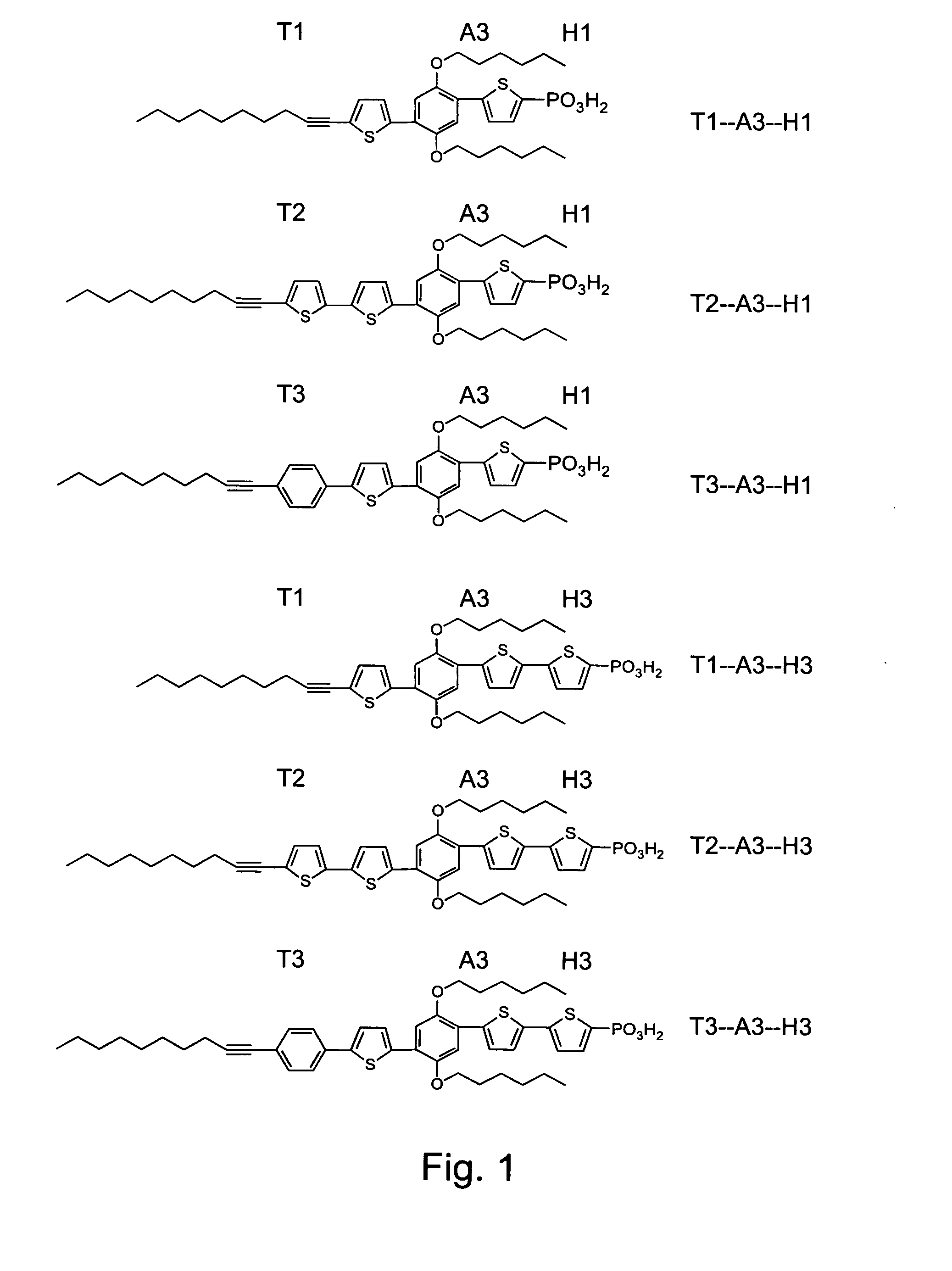Organic species that facilitate charge transfer to or from nanostructures
a charge transfer and organic species technology, applied in the field of nanotechnology, can solve the problems of polymerization and inability to make optimal contact with nanocrystals, and the charge transport within photovoltaic devices is generally limited
- Summary
- Abstract
- Description
- Claims
- Application Information
AI Technical Summary
Benefits of technology
Problems solved by technology
Method used
Image
Examples
polymer embodiment
[0095] As noted above, one or more of the constituents of the conductive compositions can optionally include polymerizable elements. The present invention also provides oligomeric and polymer conductive compositions for use with nanostructures. The oligomeric and / or polymeric compositions can be used as either coatings on nanostructures, or as the matrix into which the nanostructure in embedded. Optionally, the nanostructure is coated with a first conductive composition of the present invention, and the embedded in an additional (e.g., second) polymeric conductive composition. In an additional embodiment, different types of nanostructures (e.g., p-type and n-type nanocrystals) are coupled or crosslinked within a matrix via the conductive compositions of the present invention.
[0096] One way to accomplish efficient charge transport is by designing an electronic “stairway” for both holes and electrons via bandgap adjustment, where the matrix polymer may have a highest occupied molecul...
example 1
SYNTHESIS OF MODEL CONDUCTIVE COMPOSITION 4-DECYNYL-BENZENE-1-PHOSPHONIC ACID
[0156] A synthesis protocol was designed to test the modular approach to synthesis of the conductive compositions of the present invention (FIG. 3). The model conductive composition 5b was prepared using 1-iodo-4-bromobenzene as a precursor to the body structure, 1-decyne as the tail group moiety, and diethylphosphite as the head group moiety. To a 500 mL schlenk flask with egg-shaped stirbar under argon, palladium dichloride (1.0 mmol, 0.177 g), copper(I) iodide (2.36 mmol, 0.450 g), and triphenylphosphine (2.0 mmol, 0.525 g) were added in a glovebox under argon. On a schlenk line, 1-iodo-4-bromo-benzene (50 mmol, 14.15 g, compound 1) was added, the vessel was stoppered, and the flask was placed under vacuum and backfilled with argon (3×). The flask was fitted with a septum under positive argon pressure and degassed diisopropyl amine (100 mL) was added via cannula under positive argon pressure with stirri...
example 2
SYNTHESIS OF CONDUCTIVE COMPOSITION 16
[0159] One advantage to the methods of the present invention is the modular approach to synthesis of the various conductive compositions of interest. Using this approach allows for the preparation and use of common synthetic intermediates and core structures. An exemplary synthesis scheme for the preparation of a conductive composition of the present invention is depicted in FIG. 4 and described in further detail herein. In this modular approach, the various components of the composition (body structure, head group, tail group) are synthesized as individual structures, which are then coupled together to form the conductive composition.
[0160] Preparation of the Head Group Precursor
[0161] One common intermediate in the synthesis of some embodiments of the present invention is the activated head group precursor compound 9, which can be prepared based upon known synthetic protocols such as those provided in FIG. 4.
[0162] Coupling of Sidearm Moie...
PUM
| Property | Measurement | Unit |
|---|---|---|
| Temperature | aaaaa | aaaaa |
| Composition | aaaaa | aaaaa |
| Structure | aaaaa | aaaaa |
Abstract
Description
Claims
Application Information
 Login to View More
Login to View More - R&D
- Intellectual Property
- Life Sciences
- Materials
- Tech Scout
- Unparalleled Data Quality
- Higher Quality Content
- 60% Fewer Hallucinations
Browse by: Latest US Patents, China's latest patents, Technical Efficacy Thesaurus, Application Domain, Technology Topic, Popular Technical Reports.
© 2025 PatSnap. All rights reserved.Legal|Privacy policy|Modern Slavery Act Transparency Statement|Sitemap|About US| Contact US: help@patsnap.com



